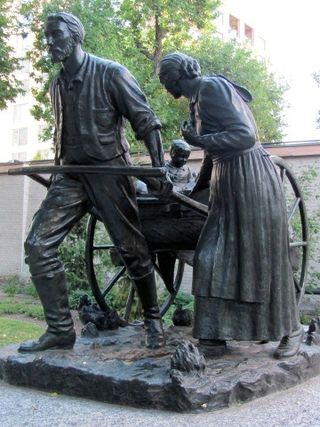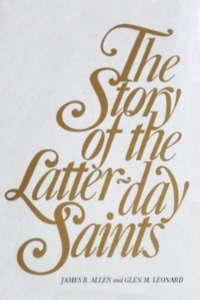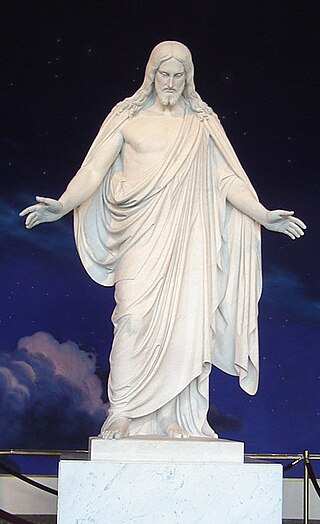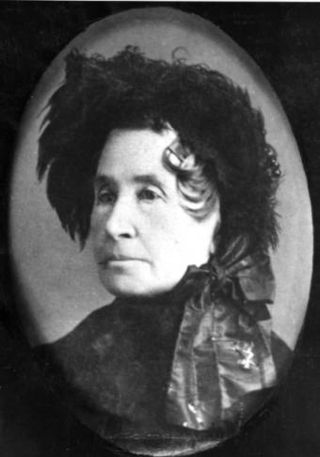Related Research Articles

Brigham Young was an American religious leader and politician. He was the second president of the Church of Jesus Christ of Latter-day Saints, from 1847 until his death in 1877. During his time as church president, Young led his followers, the Mormon pioneers, west from Nauvoo, Illinois, to the Salt Lake Valley. He founded Salt Lake City and served as the first governor of the Utah Territory. Young also worked to establish the learning institutions that would later become the University of Utah and Brigham Young University. A polygamist, Young had at least 56 wives and 57 children. He formalized the prohibition of black men attaining priesthood, and led the church in the Utah War against the United States.

Zion's Co-operative Mercantile Institution was an American department store chain. It was founded in Salt Lake City, Utah, on October 9, 1868, by Brigham Young. For many years it used the slogan, "America's First Department Store."
Eliza Roxcy Snow was one of the most celebrated Latter Day Saint women of the nineteenth century. A renowned poet, she chronicled history, celebrated nature and relationships, and expounded scripture and doctrine. Snow was married to Joseph Smith as a plural wife and was openly a plural wife of Brigham Young after Smith's death. Snow was the second general president of the Relief Society of the Church of Jesus Christ of Latter-day Saints, which she reestablished in Utah Territory in 1866. She was also the sister of Lorenzo Snow, the church's fifth president.

The Mormon Trail is the 1,300-mile (2,100 km) long route from Illinois to Utah on which Mormon pioneers traveled from 1846–47. Today, the Mormon Trail is a part of the United States National Trails System, known as the Mormon Pioneer National Historic Trail.

Leonard James Arrington was an American author, academic and the founder of the Mormon History Association. He is known as the "Dean of Mormon History" and "the Father of Mormon History" because of his many influential contributions to the field. Since 1842, he was the first non-general authority Church Historian for the Church of Jesus Christ of Latter-day Saints, from 1972 to 1982, and was director of the Joseph Fielding Smith Institute for Church History from 1982 until 1986.

Abraham Owen Woodruff was an American missionary who was a member of the Quorum of the Twelve Apostles of the Church of Jesus Christ of Latter-day Saints. He was also the son of LDS Church president Wilford Woodruff.

Charles William Penrose was a member of the Quorum of the Twelve Apostles of the Church of Jesus Christ of Latter-day Saints from 1904 to 1911. Penrose was also a member of the First Presidency, serving as a counselor to church presidents Joseph F. Smith and Heber J. Grant from 1911 until his death.

The Church Educational System (CES) of the Church of Jesus Christ of Latter-day Saints consists of several institutions that provide religious and secular education for both Latter-day Saint and non–Latter-day Saint elementary, secondary, and post-secondary students and adult learners. Approximately 700,000 individuals were enrolled in CES programs in 143 countries in 2011. CES courses of study are separate and distinct from religious instruction provided through wards. Clark G. Gilbert, a general authority seventy, has been the CES commissioner since August 1, 2021.

The Mormon handcart pioneers were participants in the migration of members of the Church of Jesus Christ of Latter-day Saints to Salt Lake City, Utah, who used handcarts to transport their belongings. The Mormon handcart movement began in 1856 and continued until 1860.

The Baker–Fancher party was a group of American western emigrants from Marion, Crawford, Carroll, and Johnson counties in Arkansas, who departed Carroll County in April 1857 and "were attacked by the Mormons near the rim of the Great Basin, and about fifty miles from Cedar City, in Utah Territory, and that all of the emigrants, with the exception of 17 children, were then and there massacred and murdered" in the Mountain Meadows massacre. Sources estimate that between 120 and 140 men, women and children were killed on September 11, 1857, at Mountain Meadows, a rest stop on the Old Spanish Trail, in the Utah Territory. Some children of up to six years old were taken in by the Mormon families in Southern Utah, presumably because they had been judged to be too young to tell others about the massacre.
Emily Hill Woodmansee was an English-born American Mormon poet and hymnwriter. Although only one of her hymns "As Sisters In Zion" is included in the 1985 LDS English language edition of the LDS Church's hymnbook, previous LDS Church hymnbooks have included more of her works.

Edward Wheelock Tullidge was a literary critic, newspaper editor, playwright, and historian of the Utah Territory, US. He was a member and leader in several different denominations of the Latter Day Saint Movement, including the Church of Jesus Christ of Latter-day Saints, the New (Godbeite) Movement movement, and the Reorganized Church of Jesus Christ of Latter Day Saints. He played a significant role in the creation of the Salt Lake Tribune newspaper.

Edwin Dilworth Woolley, Sr. was a Mormon pioneer, an early Latter-day Saint bishop in Salt Lake City, and a businessman in early Utah Territory who operated mills.

The Story of the Latter-day Saints is a single-volume history of the Church of Jesus Christ of Latter-day Saints by James B. Allen and Glen M. Leonard, first published in 1976.
James Brown Allen is an American historian of Mormonism and was an official Assistant Church Historian of the Church of Jesus Christ of Latter-day Saints from 1972 to 1979. While working as Assistant Church Historian, he co-authored The Story of the Latter-day Saints with Glen Leonard. After Ezra Taft Benson dismissed the book as secular new history, other events led to the dissolution of the LDS Church History department in 1982. Allen resigned as Assistant Church Historian in 1979, returning to work at Brigham Young University (BYU) full-time.
Eugene Edward "Gene" Campbell was an American professor of history at Brigham Young University.
The Deseret Manufacturing Company was an unsuccessful venture by the Church of Jesus Christ of Latter-day Saints in the 1850s to process sugar beets into refined sugar. A test factory was established in an area that is now known as Sugar House, Utah.
Mormon studies is the interdisciplinary academic study of the beliefs, practices, history and culture of individuals and denominations belonging to the Latter Day Saint movement, a religious movement associated with the Book of Mormon, though not all churches and members of the Latter Day Saint movement identify with the terms Mormon or Mormonism. Denominations of the Latter Day Saint movement include the Church of Jesus Christ of Latter-day Saints, by far the largest, as well as the Community of Christ (CoC) and other smaller groups, include some categorized under the umbrella term Mormon fundamentalism.

The following outline is provided as an overview of and a topical guide to the Church of Jesus Christ of Latter-day Saints.

Hannah T. King was a 19th-century British-born American writer and pioneer. Converting to Mormonism while in England, her family emigrated to the American state of Utah in 1853 where she became endeared to the people of that state. She was the author of Songs of the Heart, several poems, as well as writings addressed to young readers. King was the last woman sealed to Brigham Young. She died in 1886.
References
- ↑ "LDS Journal History". September 5, 1878.
{{cite journal}}: Cite journal requires|journal=(help) - ↑ Arrington, Leonard J. (1950–51). "Zion's Board of Trade: A Third United Order". Western Humanities Review. V (1): 5.
- ↑ Tullidge, Edward (October 1880). "Zion's Central Board of Trade". Tullidge's Quarterly Magazine. 1. 1: 418.
- ↑ Deseret News. April 20, 1881.
{{cite news}}: Missing or empty|title=(help) - ↑ Articles of association of Zion's Central Board of Trade. Zion's Central Board of Trade. 1879. p. 1. 330 A1 no.99 – via Americana Collection, Harold B. Lee Library, Brigham Young University.
- ↑ To the Stake Boards of Trade. Zion's Central Board of Trade. 1881. p. 3. 330 A1 no.84 – via Brigham Young University, Harold B. Lee Library, Americana Collection.
- ↑ Arrington, Leonard J. (1950–51). "Zion's Board of Trade: A Third United Order". Western Humanities Review. V (1): 14.
- 1 2 Arrington, Leonard J. (1950–51). "Zion's Board of Trade: A Third United Order". Western Humanities Review. V (1): 15.
- ↑ Arrington, Leonard J. (1950–51). "Zion's Board of Trade: A Third United Order". Western Humanities Review. V (1): 17.
- ↑ Arrington, Leonard J. (1950–51). "Zion's Board of Trade: A Third United Order". Western Humanities Review. V (1): 19.